Top 11 Largest Squid Species In The World
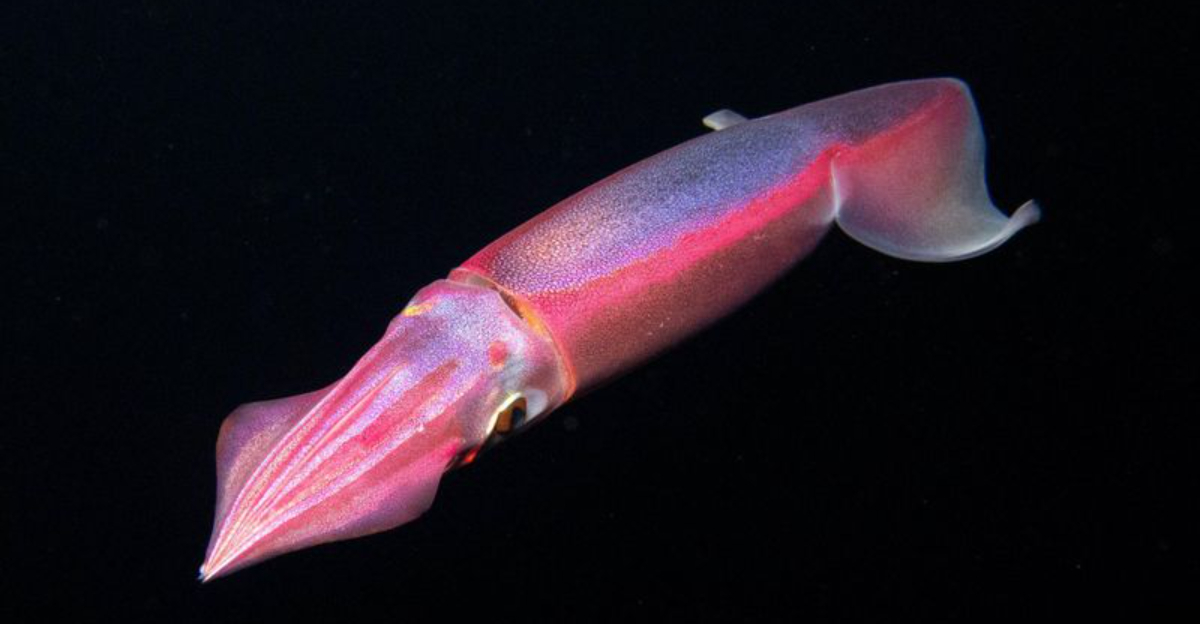
Squid are some of the most fascinating creatures in the ocean, known for their incredible size, intelligence, and unique adaptations. Among the more than 300 species of squid, the size can vary greatly, with some species reaching lengths that seem almost mythical.
Here are the top largest squid species in the world, giving you insights into their habitats, behavior, and what makes each one unique. From the elusive giant squid to the lesser-known yet equally impressive species, these cephalopods are truly a wonder of the marine world.
1. Giant Squid
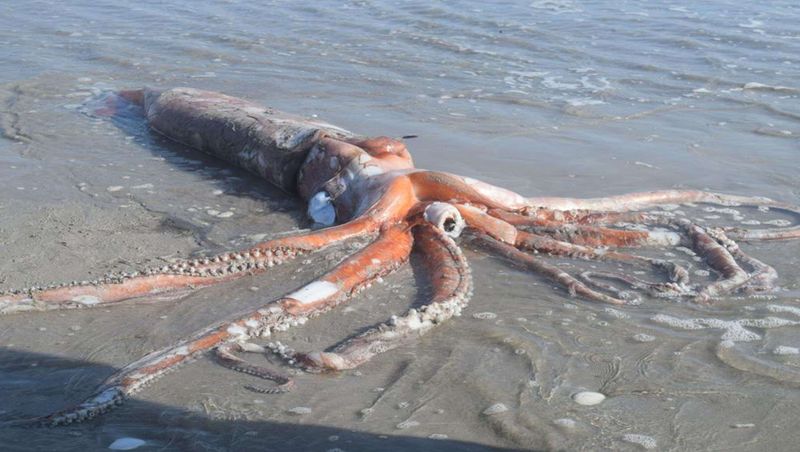
The giant squid is one of the most enigmatic creatures of the deep sea, often reaching sizes that boggle the mind. This massive cephalopod can grow up to 43 feet in length, making it one of the largest invertebrates on Earth. The giant squid’s eyes are among the largest in the animal kingdom, adapted to the pitch-black depths of its oceanic home.
A truly elusive creature, the giant squid’s habitat extends across the world’s oceans, though sightings are rare. Scientists believe it spends most of its life at depths of 300 to 1,000 meters. Recent technological advances have allowed researchers to capture footage of this deep-sea giant, shining a light on its mysterious existence.
The giant squid’s diet primarily consists of fish and other smaller squid. Its long feeding tentacles are equipped with sharp suckers, helping it capture prey with precision. This impressive predator continues to intrigue scientists and ocean enthusiasts alike.
2. Colossal Squid
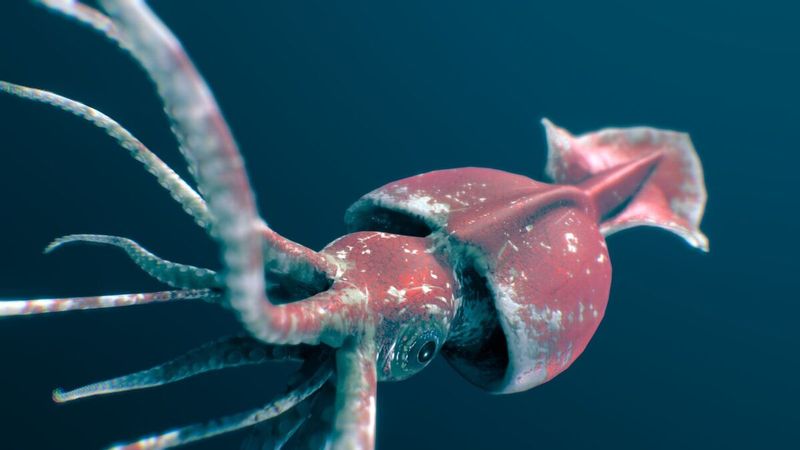
Residing in the freezing waters of the Southern Ocean, the colossal squid is a true marvel of the deep. Sometimes mistaken for its giant cousin, this species is distinct in several ways, not least its sheer mass. While it may not achieve the same length as the giant squid, it is heavier, with some specimens weighing over 1,500 pounds.
The colossal squid is equipped with unique swiveling hooks on its tentacles, a feature not found in any other squid species. These appendages make it a formidable predator, capable of tackling large prey. Its preferred diet includes Antarctic toothfish and other large marine animals.
Little is known about the daily life of the colossal squid, as it resides at depths where human exploration is challenging. However, it remains a subject of intense interest in marine biology, offering insights into the adaptations required to thrive in extreme environments.
3. Humboldt Squid
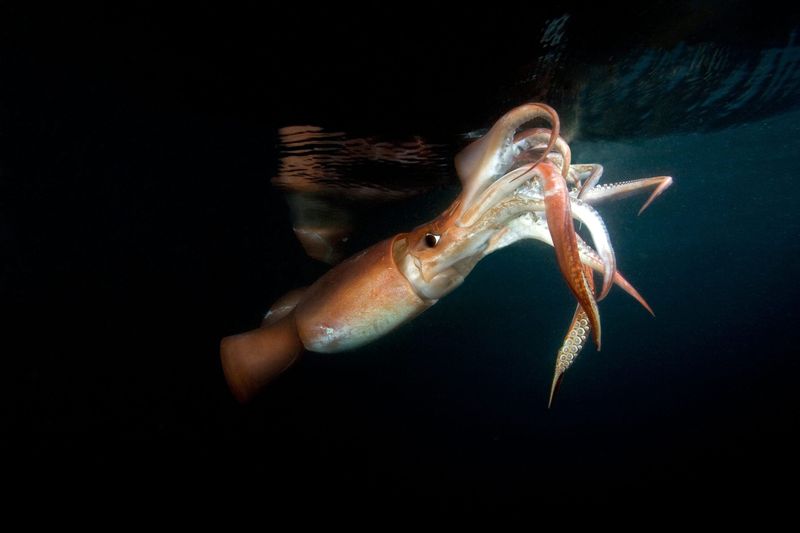
The Humboldt squid, also known as the ‘jumbo squid,’ is a striking inhabitant of the Pacific Ocean. Known for their aggressive nature, these squid can grow up to 7 feet in length and are often found in large groups, or shoals, which can number in the hundreds.
These creatures are highly efficient hunters, using their keen eyesight and speed to catch prey. They are known to exhibit aggressive behavior, often attacking fishing lures and sometimes even divers. This reputation has earned them the nickname ‘red devils’ due to their deep red coloration when agitated.
Humboldt squid are a vital part of the marine ecosystem and are a key food source for many larger predators, including sperm whales. Their ability to rapidly change color is used for communication and camouflage, making them fascinating subjects for study in cephalopod behavior and communication.
4. Dana Octopus Squid
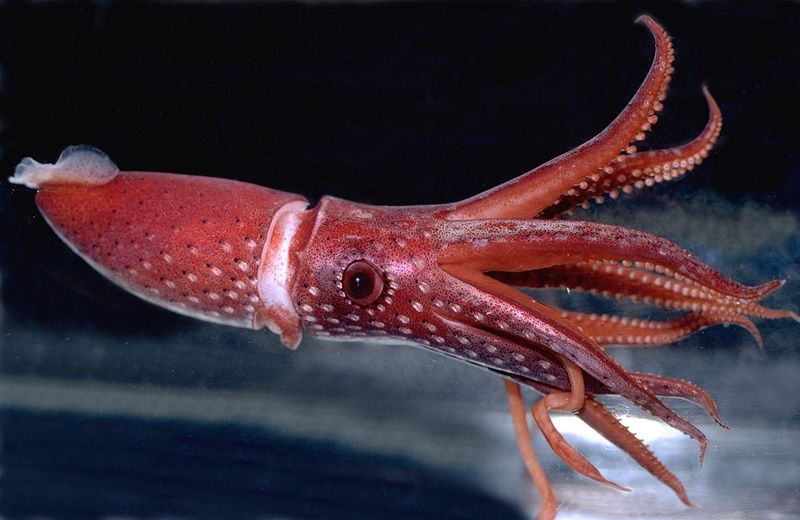
Among the midwater wonders, the Dana octopus squid stands out with its bioluminescent capabilities. Measuring up to 6.6 feet, it is a remarkable creature of the mesopelagic zone. This squid emits a blue-green glow from photophores scattered across its body, a trait that serves multiple purposes in the deep sea.
Bioluminescence is believed to play a role in communication, camouflage, and luring prey. The Dana octopus squid’s body is equipped with chromatophores that allow it to change color rapidly, a feature that aids in its survival against predators.
Primarily found in the North Pacific, this squid is a subject of scientific research focused on its unique adaptations. Its diet consists of fish and smaller squids, captured with agility and precision. The Dana octopus squid’s fascinating life in the twilight zone of the ocean makes it a standout among its cephalopod relatives.
5. Magnapinna Squid
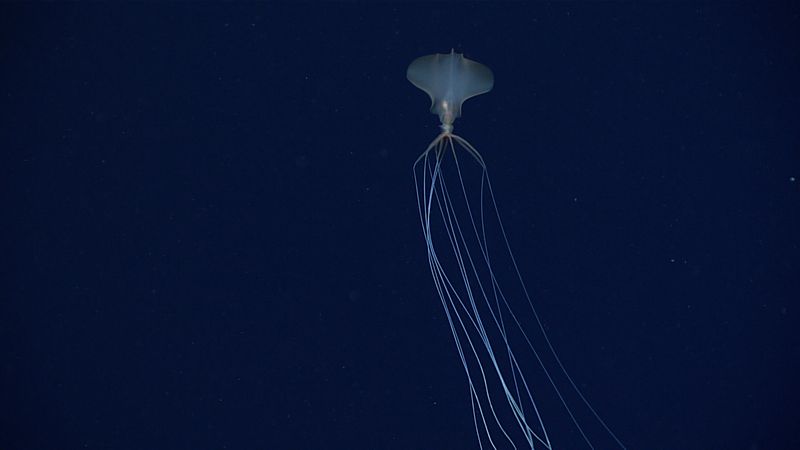
The Magnapinna squid, often referred to as the ‘bigfin squid,’ is one of the most mysterious creatures of the deep. Characterized by its long, elbow-like arms, this squid has been spotted at depths exceeding 15,000 feet. The sheer size of its limbs, which can extend up to 20 times the length of its body, sets it apart from other squid species.
Little is known about the behavior and life cycle of the Magnapinna squid, largely due to the inaccessibility of its habitat. Only a few specimens have been observed by deep-sea submersibles, making it a subject of intrigue and speculation.
This squid’s unique morphology suggests specialized feeding strategies, although precise details remain elusive. Its elongated appendages may aid in capturing prey, but much about this enigmatic creature remains a mystery, fueling ongoing research and fascination.
6. Neon Flying Squid
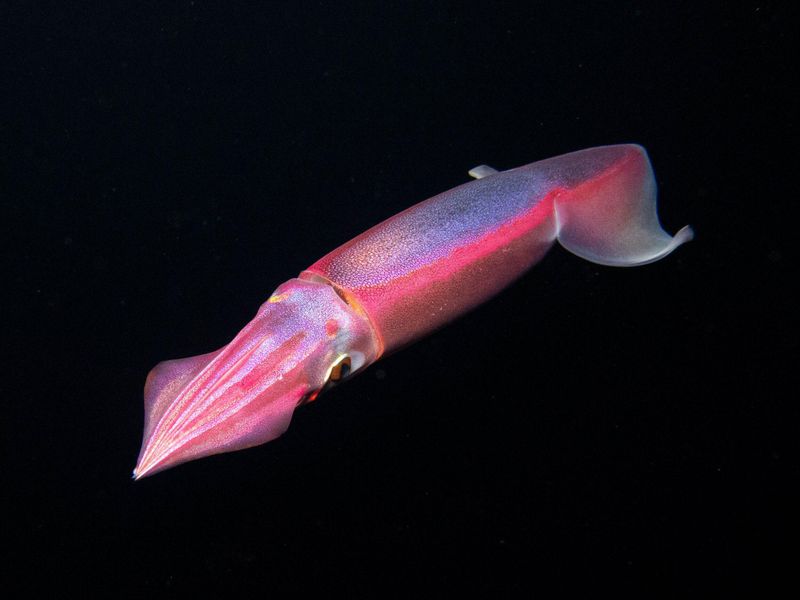
Gliding through the ocean with remarkable grace, the neon flying squid is a true spectacle. Capable of reaching lengths up to 1.5 feet, this squid is known for its ability to ‘fly’ above the water’s surface, using propulsion to escape predators and cover large distances.
Found in the North Pacific, the neon flying squid is a highly migratory species, traveling thousands of miles each year. This migration is a critical part of its life cycle, allowing it to exploit different oceanic environments for feeding and breeding.
The neon flying squid’s diet includes small fish and zooplankton, and it is a key species in the marine food web. Its ability to leap out of the water not only serves as a defense mechanism but also as a unique method of locomotion, capturing the imagination of those who study marine life.
7. Japanese Flying Squid
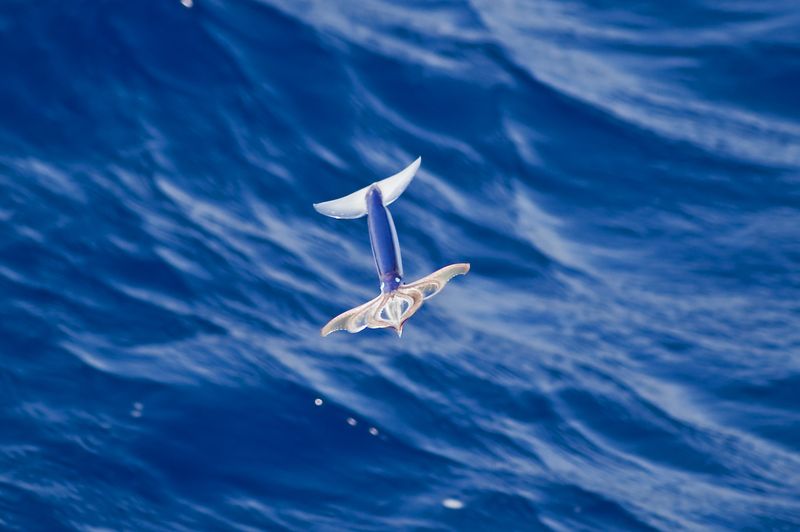
The Japanese flying squid is an agile and adaptable marine creature found in the waters of the Northwest Pacific. Often reaching lengths of up to 1.6 feet, this squid is recognized for its streamlined body and the ability to propel itself out of the water.
This species embarks on extensive migrations, moving from its spawning grounds to feeding areas across vast ocean expanses. Such journeys are essential for its survival and reproduction, with the squid adapting to different environmental conditions along the way.
The Japanese flying squid plays an important role in both natural ecosystems and human economies. It is a popular target for fisheries, providing a vital food source in many regions. Its capacity to ‘fly’ above the water and swift swimming make it a fascinating subject for marine biologists and a staple in culinary traditions.
8. Robsonella Squid
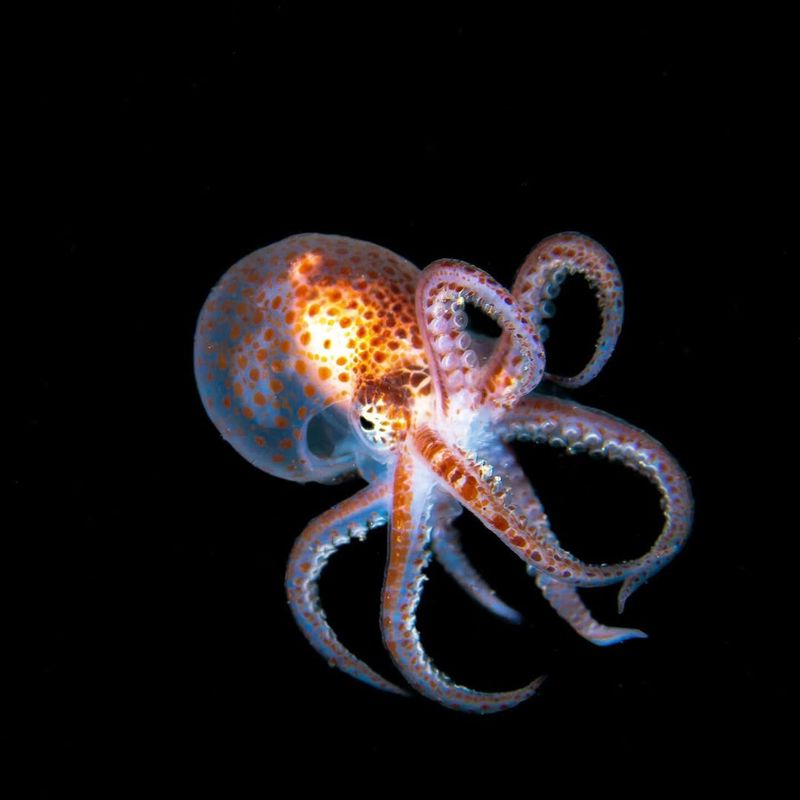
In the vibrant world of coral reefs, the Robsonella squid makes its colorful mark. Though smaller than many of its relatives, typically reaching just 8 inches, this squid is known for its striking appearance and dynamic behavior within its reef habitat.
This species thrives in the rich biodiversity of coral ecosystems, where it plays a crucial role in the food web. Its diet consists of small fish and crustaceans, and it uses its adept hunting skills to secure meals. The Robsonella squid’s ability to change color rapidly aids in communication and camouflage.
Uniquely adapted to its environment, the Robsonella squid’s vibrant coloration and active lifestyle make it a subject of interest for marine ecologists. Its presence in coral reefs highlights the complex interactions among species in these underwater paradises, where every creature has a part to play.
9. Diamondback Squid
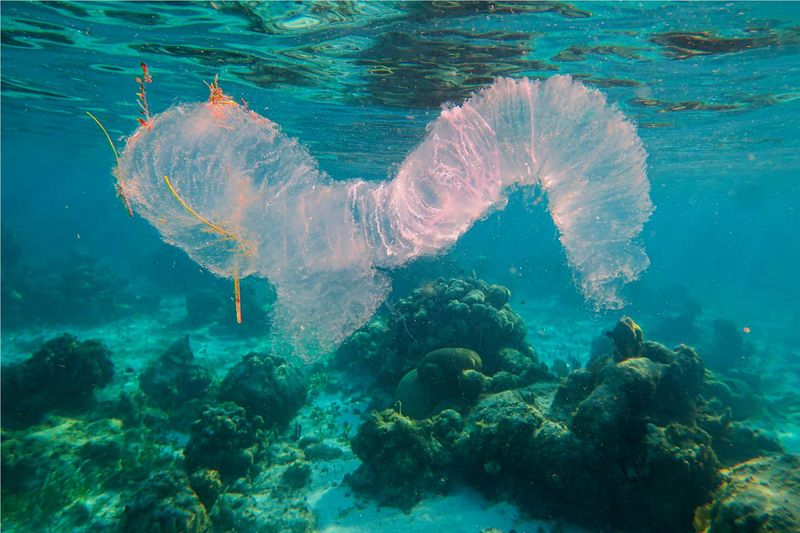
Dwelling in the twilight zone of the ocean, the diamondback squid is an intriguing species with a distinctive appearance. Growing up to 3 feet in length, it is named for the diamond-shaped fins that adorn its body, providing stability and agility in the water.
The diamondback squid inhabits mesopelagic depths, where light is scarce, and conditions are challenging. It is well adapted to this environment, using bioluminescence to communicate and avoid predators. Its diet mainly consists of small fish and other cephalopods, captured with precision by its long tentacles.
Scientists study the diamondback squid to understand its role in the marine ecosystem and the adaptations that allow it to thrive in such unforgiving habitats. Its unique features and behaviors offer valuable insights into the complexity of oceanic life, making it a fascinating subject for marine research.
10. Jumbo Squid
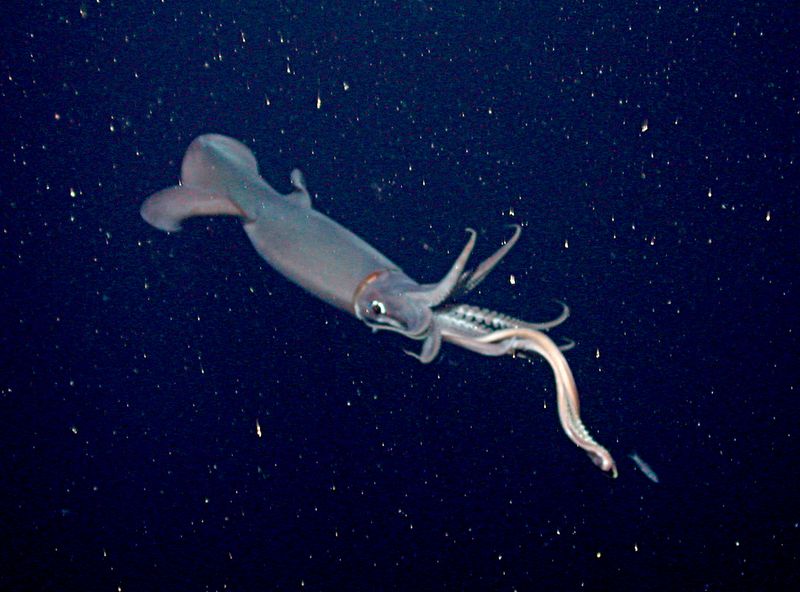
The jumbo squid, aptly named for its impressive size, is a prominent resident of the Gulf of California. Reaching up to 7 feet in length, this species is known for its voracious appetite and striking color changes, especially when hunting or threatened.
Jumbo squids are social creatures, often found in large groups, making them a common sight in their native waters. They play a crucial role in the marine food chain, serving as both predator and prey, with a diet that includes fish and other squids.
Their rapid color changes are not just for show; these patterns are used for communication within shoals and to ward off predators. The jumbo squid’s dynamic nature and large population make it an essential study subject for understanding oceanic ecosystems and the impact of environmental changes on marine life.
11. Firefly Squid
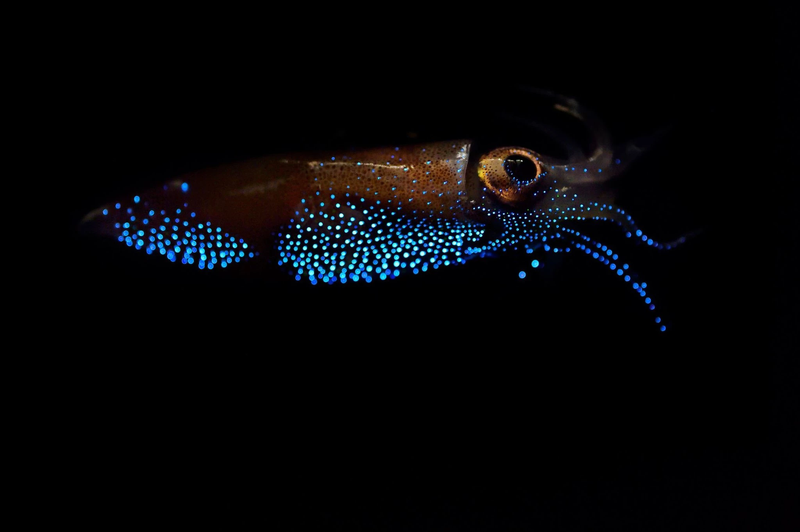
The firefly squid, a small yet mesmerizing inhabitant of the Sea of Japan, captivates with its bioluminescent display. Measuring just 3 inches in length, this squid is renowned for its ability to produce light, a spectacle that draws tourists and scientists alike.
The firefly squid’s bioluminescence is used for communication, attracting mates, and deterring predators. Thousands of tiny light-producing organs line its body, creating a dazzling show in the dark waters. This display becomes particularly prominent during the squid’s breeding season, drawing visitors to witness the enchanting natural phenomenon.
Despite its small size, the firefly squid plays a significant role in its ecosystem, feeding on plankton and serving as prey for larger marine animals. Its fascinating light displays and ecological importance make it a beloved subject of marine study and a popular attraction in its native waters.






